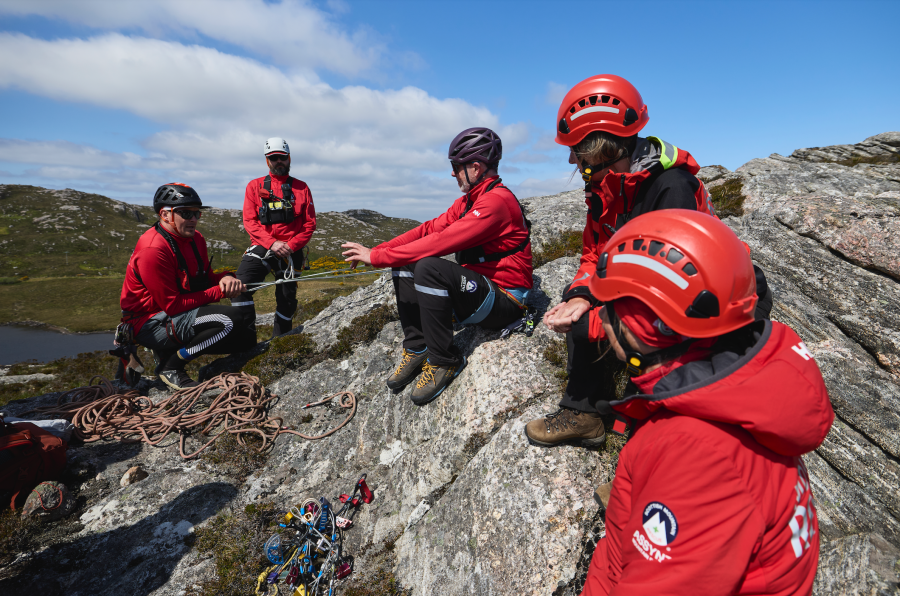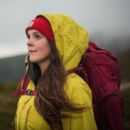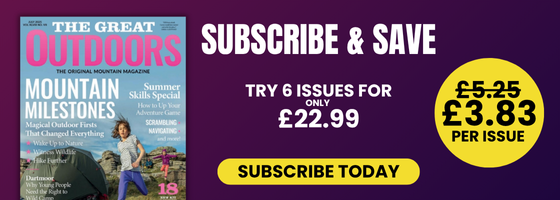This Q&A with Ben Dyson, Team Leader at Assynt Mountain Rescue, is sponsored by our friends at Helly Hansen.
It’s rare that you’ll hear a member of Mountain Rescue Teams across Scotland, England and Wales talk about their own comfort in the hills and mountains. Volunteers are, in my experience, more likely to prioritise conversations around the safety and wellbeing of those in need in high places. And yet, on each one of the hundreds of callouts answered each year, it’s vital that members of Mountain Rescue Teams trust in their kit to keep them comfortable enough to save lives outdoors 24 hours a day, 365 days a year, in any weather. So, The Great Outdoors asked Ben Dyson, Team Leader for Assynt Mountain Rescue Team, celebrating a four-year partnership with Helly Hansen, about life in the mountains and why kit that looks after the team is non-negotiable. Ben, who is also a freelance environmental consultant by day, also teases some future developments on the sustainability agenda at Helly Hansen and Assynt Mountain Rescue – covering one of the largest areas covered by a single mountain rescue team in the UK at 7500km2 – too.
Main image: Learning the ropes on an Assynt Mountain Rescue Team training day | Credit: Ed Smith

TGO: Each MRT team has to deal with a specific set of call outs depending on the landscape and terrain covered and how people move through it. Can you describe the unique characteristics of Assynt?
Ben: Assynt MRT covers the most Northerly part of the Scottish mainland, from Dornoch on the East Coast, to just North of Ullapool on the West. It is one of the largest areas covered by a single mountain rescue team in the UK, which at 7500km2, is more than half the size of Northern Ireland! The landscape is diverse with rugged mountains and lochs on the West, contrasted by the vast peat flows of Caithness to the North East. Our patch also includes the majority of the NC500 tourist route that brings tens of thousands of visitors to the area every year.

TGO: On an average summer month, what kind of call outs does Assynt MRT deal with?
Ben: We tend to be busier in the Summer months as a result of the huge increase in the number of people visiting the area. This means the type of callout varies significantly from assisting lost or injured hill walkers to large multi-agency searches for missing people. Sometimes we get something out of the ordinary crop up, for example, last year when we rescued a 60kg Cane Corso Mastiff that had been stuck on a cliff edge for seven days.
Thankfully, most call outs are not serious and working alongside our partners at Police Scotland, HM Coastguard and Scottish Ambulance Service, means the outcomes are often positive.

TGO: What about the winter and shoulder seasons?
The Winter and shoulder seasons are normally quieter, but when the phone rings it is often more serious. What makes every callout more serious in Autumn, Winter and Spring is due to the more challenging weather and shorter daylight hours. And, given the huge area we cover, it is not uncommon for it to take up to three hours to just reach a casualty – add that to the high chance it being cold, wet and windy, means that the chances of hypothermia increase significantly, which only adds to the complexity and severity of the incident.
TGO: And how does the kit volunteers are supplied by Helly Hansen cope in the conditions and terrain?
The team has been working with Helly Hansen for nearly four years now and the kit they supply is tough, functional and most importantly, reliable. It deals well with the unforgiving nature of the Scottish mountain environment, especially during the colder months when the last thing you need is to be worrying about is whether or not your kit is up to the job.

Before our partnership began, we spent a long time trialling kit with Helly Hansen, giving them honest and real-life feedback from our day-to-day work. This feedback forms part of our uniform process, ensuring it delivers for us every single day and allows the Helly Hansen to adapt to our changing needs – whether it’s the size or location of a pocket or zip, through to the weight and packability of the kit. These are all very real pieces of feedback that can have an incredible impact on our comfort and/or ability to do our job.
TGO: In your time with Assynt MRT, you’ve served as medical officer and a search and rescue drone pilot. How does the kit suit the many varying needs of the different team roles and the extensive equipment you’ll need to carry up to a call out?
Ben: As one of the team’s Remote Rescue Medical Technicians, I have often been deployed as part of the team’s “hasty party”, meaning I was often one of the first team members to reach casualties on the hill. This requires moving quickly on often steep terrain carrying a heavy pack, along with other vital team equipment. Therefore, our clothing needs to be lightweight, comfortable and breathable – and Helly Hansen’s iconic baselayers and Odin collection are ideal, particularly for optimal movement, breathability and moisture management.

The brand’s Helly Tech® technology has also been a game-changer for us – offering a tough weatherproof outer layer, specifically designed for the harshest conditions, designed as a combination of a DWR-treated outer fabric, and a highly breathable and waterproof membrane. Piloting a drone is often the opposite to this as you are standing still for long periods of time, and therefore demand warm, well-insulated and wind proof garments, allowing team members to concentrate on the job in hand.
TGO: We don’t often talk about the comfort of Mountain Rescue volunteers on call outs – the focus justifiably being on the hard work and dedication of the team members! But I’m wondering how much easier it makes your (voluntary) job when the kit serves the purpose well?
Ben: There is an awful lot to think about when operating as a mountain rescue volunteer. We need to look after ourselves, our team mates and our equipment, as well as the casualties we are there to assist. Therefore, having kit that looks after us first is vital in ensuring we can do the best possible job for our casualties.

We are grateful to be working with Helly Hansen, with them providing kit that enables us to perform at our best so we can focus entirely on the job in hand. It’s also really important to our team that we can provide real-life experiences and feedback to the brand, enabling us to develop and expand on our kit collection, making it the best it truly can be.
TGO: You’re a freelance environmental consultant in your day job. How important is to you that your kit has good eco credential and durability in order to alleviate some of the environmental pressures of the outdoor gear industry?
This is a very important consideration, for me personally and for Assynt Mountain Rescue Team as an organisation and we have a policy to ensure the goods and services we utilise must meet optimal standards for sustainability. In this regard, we have been impressed by Helly Hansen’s responsible approach to sourcing materials, innovative manufacturing processes, fair working practices and how the brand considers the entire life cycle of their products.
We know there is more happening as part of future developments too, and we are excited to be a part of this journey and to be able to instil more advanced sustainability practices into our organisation in the years ahead.

TGO: Finally, how can the outdoor industry – and the outdoor-going public – continue to best support Scottish Mountain Rescue Teams?
Ben: Both already do a lot and for that we are truly grateful! There are currently 27 volunteer mountain rescue teams in Scotland – all of which are highly reliant on public support to continue being available for call outs twenty-four hours a day, three hundred and sixty-five days a year.
Currently, Assynt Mountain Rescue Team receives around a third of the funding required to run our team from the Scottish Government and Police Scotland. The other two thirds are raised from public donations and the generous support of businesses such as Helly Hansen. There are numerous ways to support mountain rescue teams, from simply making a donation to organising a fundraising event or activity.
As such, I would greatly encourage anyone reading this to get in touch with their local MRT or a national body – such as Scottish Mountain Rescue – and ask how you can help.
For the general public, it’s also important to educate themselves on basic mountain safety ahead of any trips or adventures, ensuring you have the right clothing and equipment, water and snacks, a means of calling for help if needed and a copy of plans at home, should you get into trouble.
Learn more in this Helly Hansen guide to hiking for beginners.








